MPAS Goals and Competencies
Mission, Vision, Goals, and Outcomes
The MPAS Program at Trine University will provide an outstanding educational experience that produces PA graduates capable of delivering safe, appropriate, effective, and cost-efficient medical care in a variety of clinical settings, while also preparing them to succeed, lead, and serve.
The MPAS Program at Trine University will provide a dynamic and engaging medical education to students using a combination of traditional and case-based learning experiences with emphases on professionalism, interprofessional collaborative practice, and safe, appropriate, effective, and cost-efficient medical care.
The Trine University Master of Physician Assistant Studies program aspires to meet the following goals:
- Educate and prepare competent physician assistants.

Trine MPAS students have met or exceeded the national average score on the first attempt of the PANCE two out of the last three years.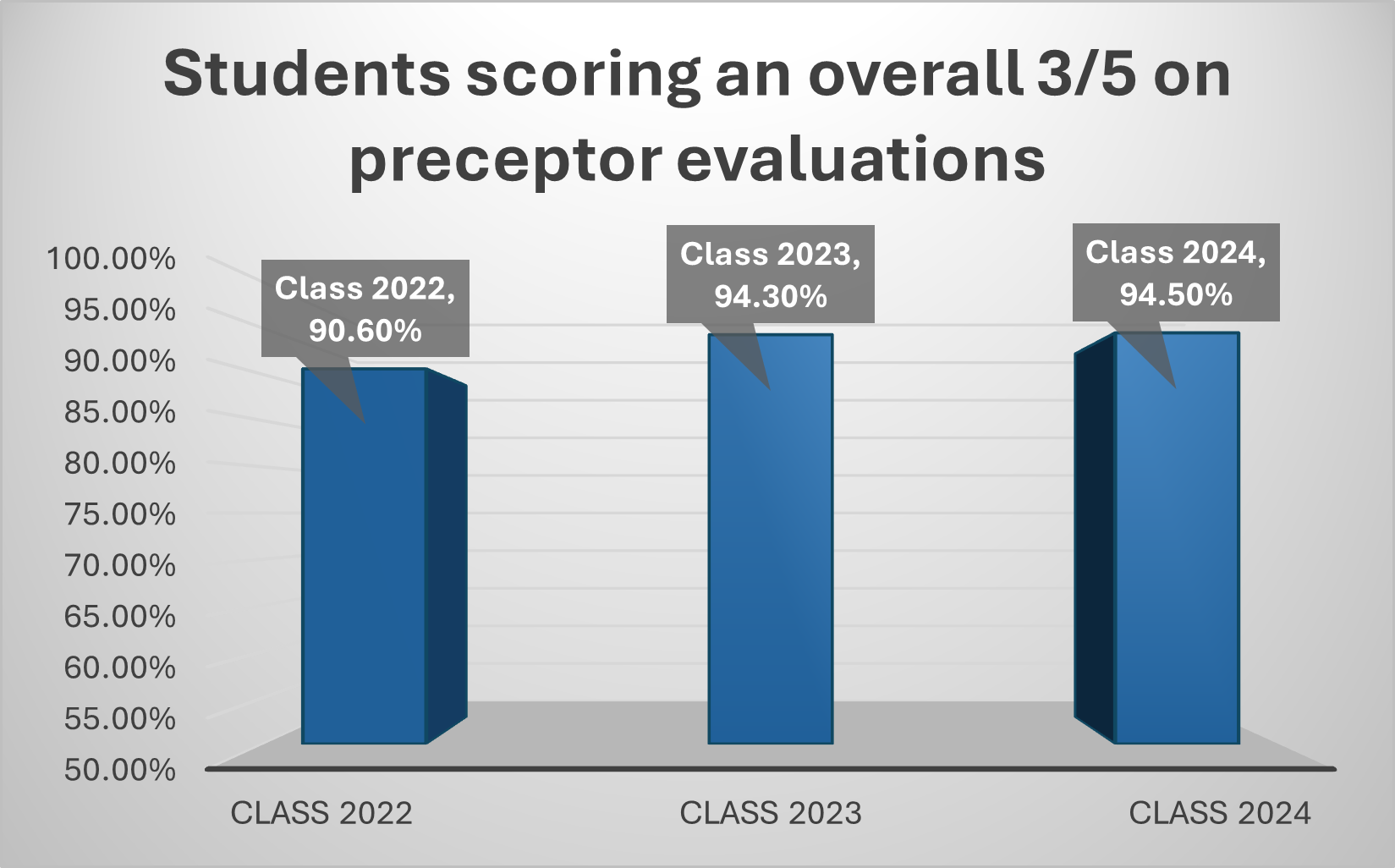
When we look at the peer perspective, healthcare providers serving as preceptors score our clinical year students above average in all areas of knowledge, skill and competency. 3.0/5.0 is considered average, the above graph shows the percent of each cohort that received over a 3.0 on all their clinical rotation evaluations.
When we look at the graduate perspective, upon graduation, students are asked, “Did the program affectively prepared me to meet the program learning outcomes, competencies to enter clinical practice”. The last three cohorts all felt prepared to begin clinical practice, rating us significantly above the 3.5 benchmark, with a 3.0/5.0 equaling neutral. - Prepare physician assistant to deliver care across a variety of clinical settings.
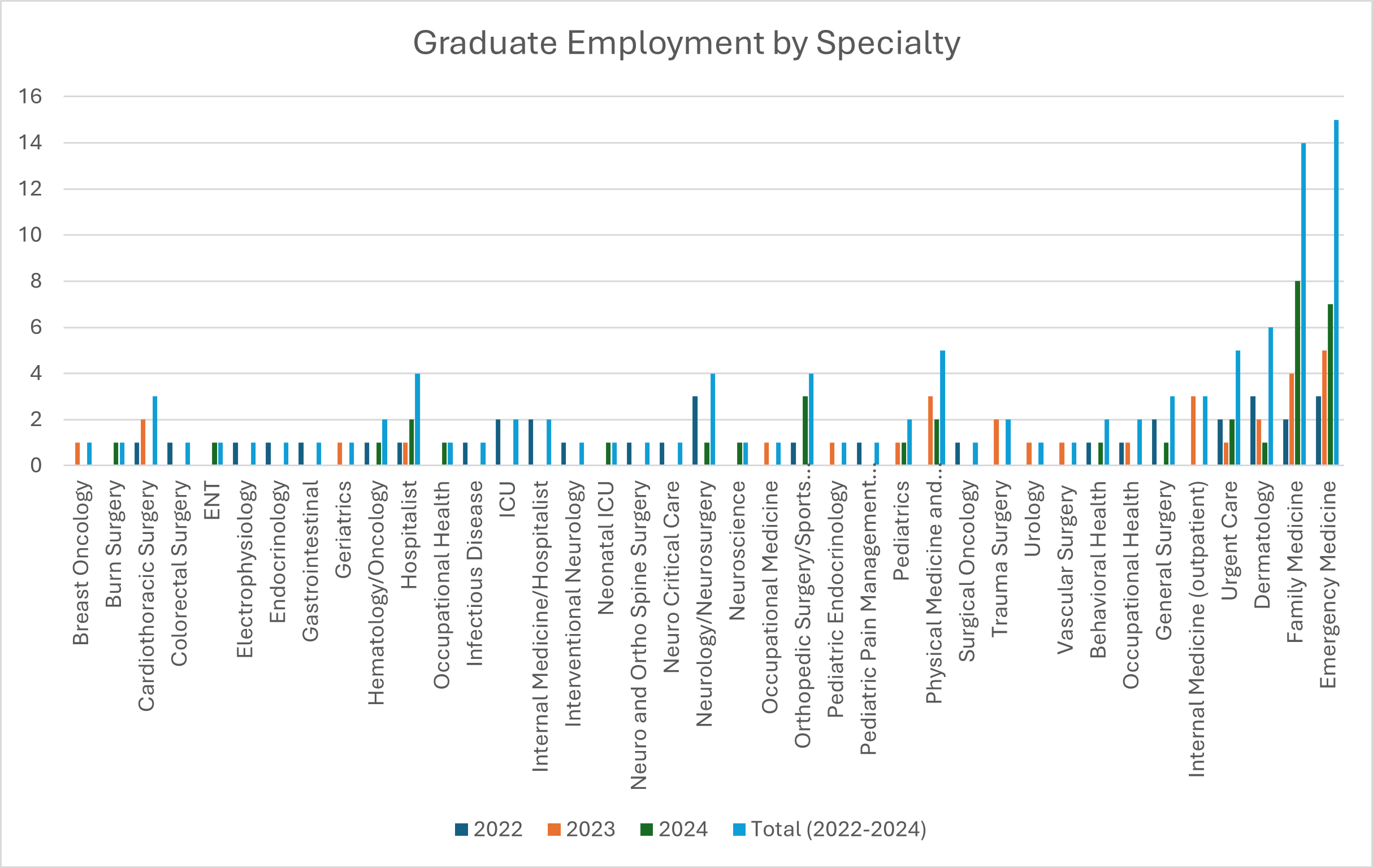
Our goal is to prepare physician assistants who are confident and capable of practicing in a wide range of clinical settings. Every student is guaranteed rotations in at least seven distinct specialties, with hands-on experience in inpatient, outpatient, emergency, and surgical care. By offering this breadth of training, we equip our graduates with the flexibility to enter diverse areas of practice. We monitor our success through alumni feedback, aiming to see our graduates thriving across at least five distinct specialties. Currently our graduates are employed in 39 distinct specialties. - Foster a commitment to service by caring for underserved populations.
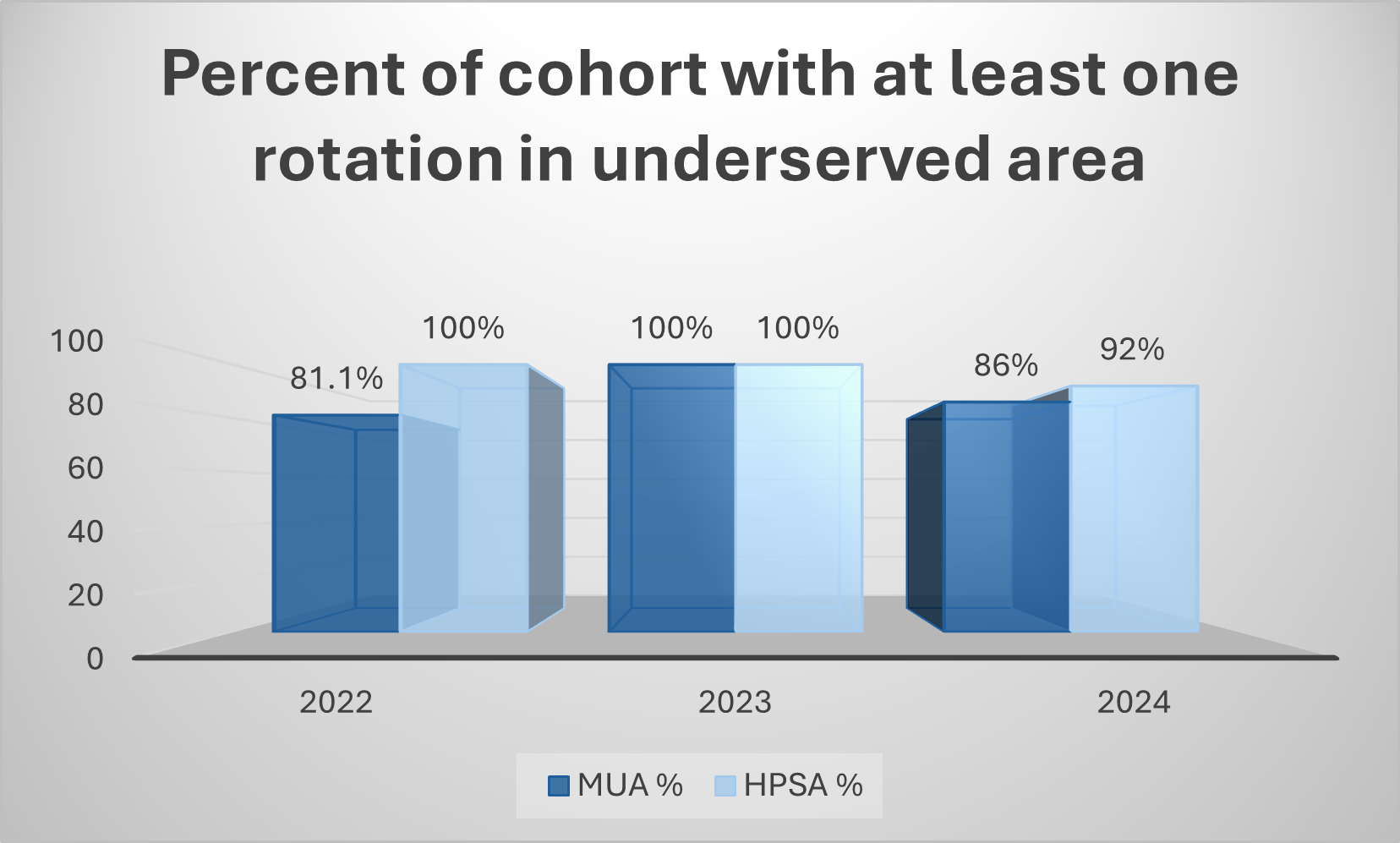
One of the primary goals of the physician assistant career is to reduce healthcare disparity. To prepare our graduates to meet this goal, we ensure they gain experience caring for underserved populations by striving for every student to complete at least one supervised clinical practice experience in an underserved area. * MUA: Medically underserved Area, HPSA: Health Professional Shortage Area - Cultivate professional physician assistant leaders.
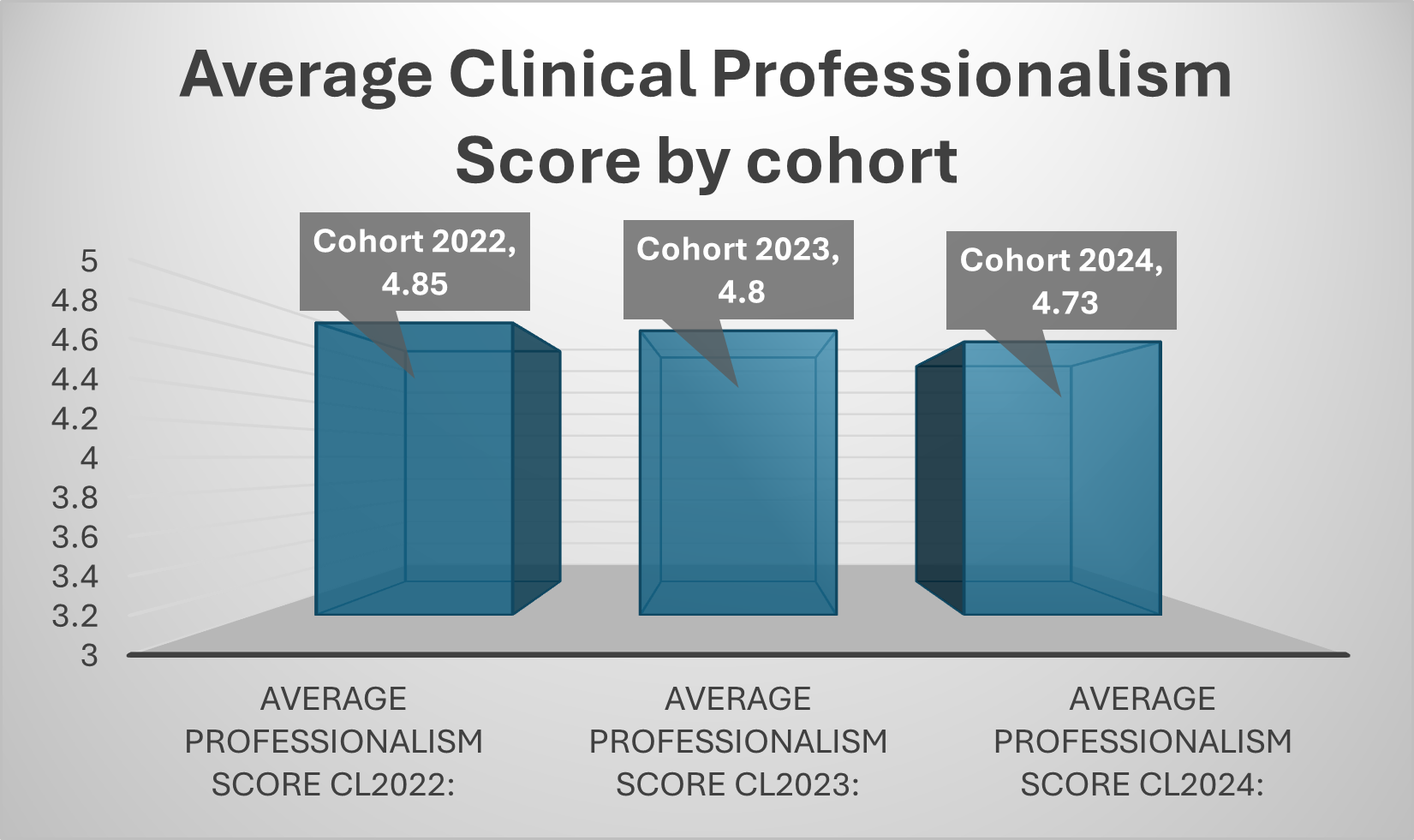
We strive to produce Physician Assistants that are professional leaders. In evaluating our students, we review the professionalism scores they receive throughout their education. We compare the student’s scores from their 9+ preceptors with their assessments done by faculty and peers. Above is how our students are perceived professionally by other healthcare professionals. Our benchmark is a 3.0/5.0, demonstrating average professionalism. Our students consistently score above benchmark with a cohort average of 4.79.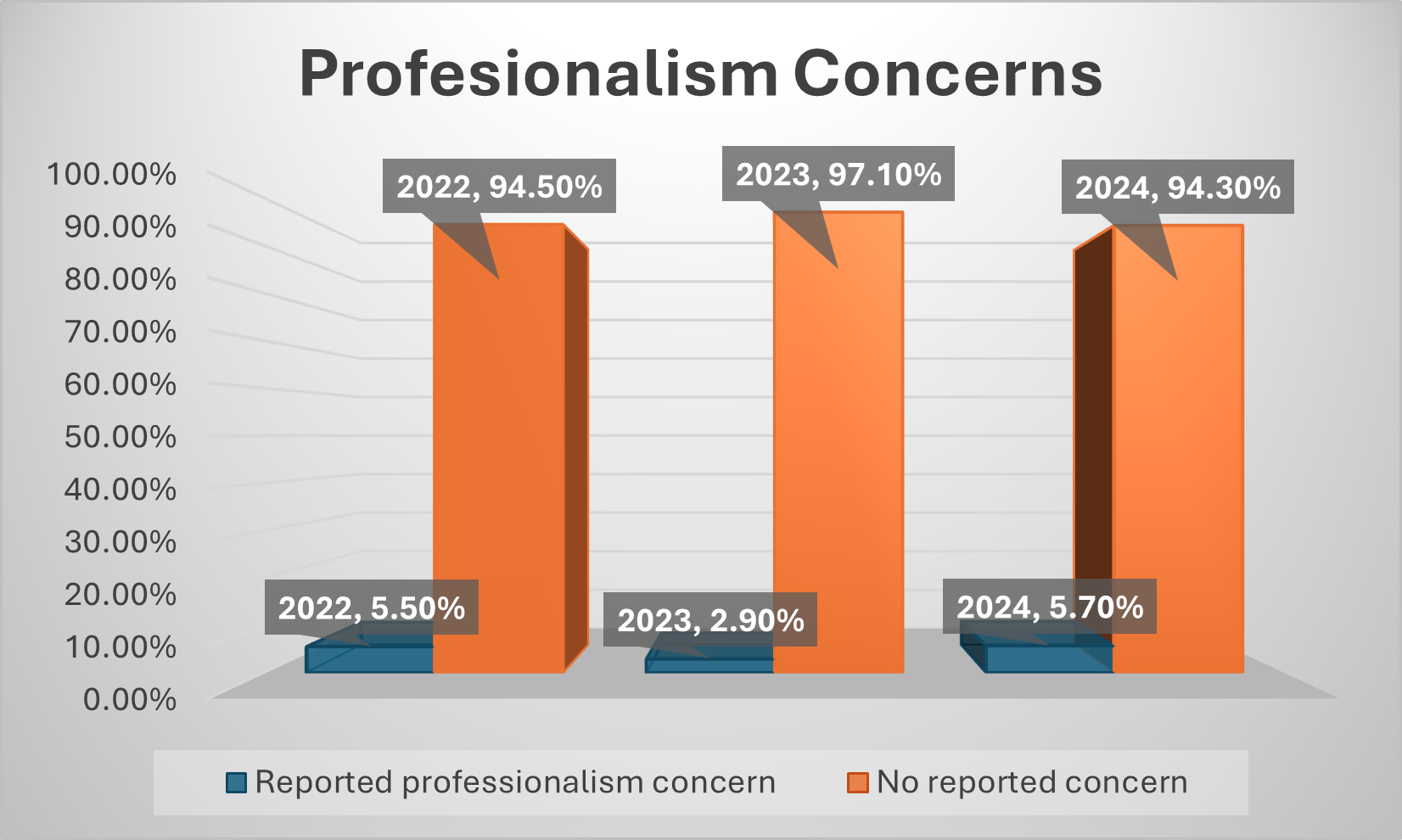
Student professionalism is formally evaluated by both faculty and clinical preceptors. The total number of reported professionalism concerns is tracked by cohort from all sources. Overall, our students demonstrate strong professional behavior, with nearly 95% of each cohort consistently having no reported concerns.
The Trine University Master of Physician Assistant Studies Program has established academic standards and goals for student learning which provide a critical foundation for curriculum development, guideposts for classroom instruction, and a framework for assessment. (B4.03)
By the end of the MPAS program, the graduating student should be able to:
1.1 Possess a sound knowledge of current and evolving biomedical and clinical sciences, and integrate and apply it to the medical care, health promotion, and disease prevention services offered (B1.01c)
1.2 Participate in lifelong learning to continually improve clinical knowledge, clinical and technical skills, professional behaviors, and clinical reasoning and problem-solving abilities (B2.03, B2.05, B2.09, B2.18, B2.19)
1.3 Possess sufficient knowledge of the medicolegal, regulatory, billing/coding, reimbursement, and patient safety issues inherent to medical practice (B2.14, B2.16, B2.17)
1.4 Possess the knowledge and abilities to critically evaluate the medical literature, conduct or participate in limited research projects, and evaluate clinical environments and processes for quality, efficacy, compliance, patient safety, risk management, or other important outcomes that may impact patient care (B2.13)
2.1 Accurately and efficiently perform medical histories and physical examinations across the lifespan that are appropriate and relevant to the clinical situation and setting (B2.07)
2.2 Appropriately order and correctly interpret laboratory, imaging, ECG, and other diagnostic studies commonly performed in clinical settings (B2.07)
2.3 Skillfully perform diagnostic and therapeutic procedures most commonly performed by PAs (B2.07)
3.1 Effectively and efficiently utilize information from the health history, physical examination, laboratory tests and other diagnostic procedures to distinguish between expected vs. abnormal findings, to formulate reasonable differential diagnoses, and to narrow the differential diagnosis list to a presumptive diagnosis in a logical, efficient, and cost-effective manner (B2.07)
3.2 Recommend pharmacologic and non-pharmacologic therapeutic options that are most efficacious and evidence-based while also considering patient preferences and concerns, and the impacts of social, economic, and spiritual factors on health and wellness (B2.06)
3.3 Provide appropriate medical care in emergent, acute, chronic, rehabilitative, palliative, and end-of-life settings (B2.08)
3.4 Assess patient outcomes to evaluate the accuracy of diagnoses, the effectiveness of therapeutic interventions, patient compliance, and other factors that potentially impact patient care (B2.07, B2.12)
4.1 Effectively utilize both electronic and non-digital medical records to document findings, access clinical information, write prescriptions and orders, and make referrals (B2.07, B2.14)
4.2 Utilize technologies and other resources to effectively search, interpret, and appraise the medical literature for answers to clinical questions and evidence-based practices, and integrate and apply newly acquired knowledge into patient care (B2.13)
5.1 Document and communicate medical, legal, financial, or other relevant information to other members of the healthcare team in an accurate, logical, concise, and understandable manner (B2.04, B2.10, B2.17)
5.2 Demonstrate appropriate and effective auditory, verbal, non-verbal, written, and electronic communication skills when dealing with patients, families, caregivers, staff, colleagues, supervising physicians, administrators, and other healthcare professionals (B2.04, B2.10)
5.3 Demonstrate appropriate sensitivity, empathy, compassion, and respect when dealing with diverse patient populations to promote and sustain therapeutically and ethically sound relationships (B2.06, B2.11, B2.12, B2.15)
6.1 Abide by, and uphold, the principles espoused in the “PA Professional Oath” and the American Academy of Physician Assistant’s “Guidelines to the Ethical Conduct of the Physician Assistant Profession” (B2.18)
6.2 Demonstrate and model professional behavior, most especially in interactions with patients, families, staff, colleagues, and superiors (B2.18)
6.3 Abide by legal and regulatory requirements pertaining to the PA profession and clinical practice settings (B2.17, B2.18)